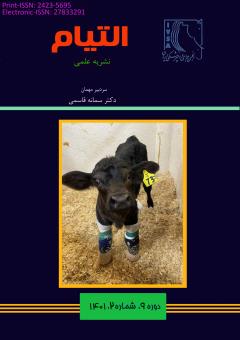قطع انگشت در گاو
محورهای موضوعی : علوم جراحی دامپزشکی شامل جراحی های بافت های سخت و نرم
سجاد پیش بین
1
,
فرزاد حیاتی
2
*
![]()
1 - دانشجو، گروه علوم درمانگاهی دانشکده دامپزشکی دانشگاه فردوسی مشهد، مشهد، ایران
2 - استادیار، گروه علوم درمانگاهی دانشکده دامپزشکی دانشگاه فردوسی مشهد، مشهد، ایران
کلید واژه: قطع انگشت, گاو, لنگش,
چکیده مقاله :
لنگش در اندام های حرکتی یکی از مهم ترین مشکلات گاوداری های امروز است که ضررهای اقتصادی جبران ناپذیری ایجاد می کند به طوری که حدود 60% گاوهای هر گله حداقل در طول سال یکبار دچار لنگش می شوند (جراحات انگشتی در ایران 8/31%). جراحات انگشت ها یکی از اصلی ترین دلایل لنگش در گاوها است. استخوان های انگشت ها در گلو شامل بند های اول، دوم و سوم هستند. دو انگشت فرعی نیز در گاو وجود دارند. انگشت میانی و انگشت جانبی به ترتیب در اندام های حرکتی جلویی و عقبی ساختار های اصلی تحمل وزن هستند. یکی از درمان های کاربردی برای جراحات انگشت ها، قطع آن ها است. از میان مهم ترین علل قطع انگشت می توان به استئومیلیت های استخوان های انگشت ها و ناویکولار، آرتریت های عفونی مفاصل بین انگشتی، شکستگی ها و ضربات سم اشاره کرد. اغلب جراحی های قطع انگشت تحت بیحسی موضعی در گاو در حالت ایستاده انجام می شود. انتخاب روش های قطع انگشت بستگی به عوامل مختلفی مانند نوع جراحت و وسعت ساختارهای آناتومیکی درگیر دارد. معمول ترین روش جراحی، قطع انگشت ها قطع انگشت از طریق یک سوم انتهایی استخوان بند بالایی بدون نیاز به آویخته پوستی است که معمولا پیش آگهی خوبی نیز دارد و در بهبود عمر اقتصادی دام موثر است. امروزه، قطع اندام و استفاده از پروتز در گاو و گوساله با صدمات غیر قابل درمان عضلانی اسکلتی یا عفونت کاربرد دارد. هر چند پیش آگهی کوتاه مدت قطع اندام خوب است، پیش آگهی طولانی مدت بستگی به تحمل وزن و شرایط نگهداری حیوان دارد.
Lameness of limbs is one of the most important problems of today's cattle farms, which causes irreparable economic losses, so that about 60% of cows in each herd are lame at least once a year (finger injuries in Iran are 31.8%). Injuries of the digits is one of the major causes of lameness in cattle. Bones of the digits in cattle include the first, second and, third phalanx. Two vestigial digits are existed in cattle. The medial digit and the lateral digit are the main weight bearing structures on the forelimb and hindlimb, respectively. One of the practical treatments for injuries of the digits is its amputation. Among the most important causes of digit amputation, can mention osteomyelitis of finger and navicular bones, septic arthritis of interdigital joints, fractures and hoof traumas that have not responded to other conservative treatment. Most of digit amputation procedures perform under local anesthetic techniques with the cattle standing position. Selection of digit amputation techniques depends on several factors, such as the lesion type and the extent of involved anatomical structures. The most common surgical method is to amputate the digit through the distal aspect of the proximal phalanx without the need for a skin flap, which usually has a good prognosis and is effective in improving the economic life of the animal. Todays, limb amputation and the use of prosthesis are indicated in cattle or calf with untreatable musculoskeletal trauma or infection. General anesthesia is recommended for limb amputation. Although the short-term prognosis for limb amputation is good, the long-term prognosis depends on the weight of the animal and caring condition.
1. Clark C, Petrie L. Fracture toughness of bovine claw horn from cattle with and without vertical fissures. The Veterinary Journal. 2007;173(3):541-7.
2. A. David Weaver OA, Guy St. Jean, Steiner. AA. Bovine Surgery and Lameness. 3 ed2018. 315-320.
3. Kofler J, Feist M, Starke A, Nuss K. Resection of the distal/proximal interphalangeal joint and digit amputation in 21 breeding bulls--indications, clinical findings and longterm outcome. Berliner und Munchener Tierarztliche Wochenschrift. 2007;120(3-4):156-64.
4. Kofler J. Clinical study of toe ulcer and necrosis of the apex of the distal phalanx in 53 cattle. The veterinary journal. 1999;157(2):139-47.
5. Simpson KM, Streeter RN, Jones ML, Taylor JD, Callan RJ, Holt TN. Review of digital anatomy, infectious causes of lameness, and regional intravenous perfusion in cattle. The Bovine Practitioner. 2020:17-29.
6. Nuss K. Surgery of the distal limb. Veterinary Clinics: Food Animal Practice. 2016;32(3):753-75.
7. Greenough P, Ferguson JG. Alternatives to amputation. Veterinary Clinics of North America: Food Animal Practice. 1985;1(1):195-203.
8. Desrochers A, Anderson DE, Jean GS. Surgical diseases and techniques of the digit. Veterinary Clinics of North America: Food Animal Practice. 2008;24(3):535-50.
9. Heppelmann M, Kofler J, Meyer H, Rehage J, Starke A. Advances in surgical treatment of septic arthritis of the distal interphalangeal joint in cattle: A review. The Veterinary Journal. 2009;182(2):162-75.
10. Desrochers A, St-Jean G, Anderson DE. Limb amputation and prosthesis. Veterinary Clinics: Food Animal Practice. 2014;30(1):143-55.

